颈静脉孔区解剖
颅底解剖详解
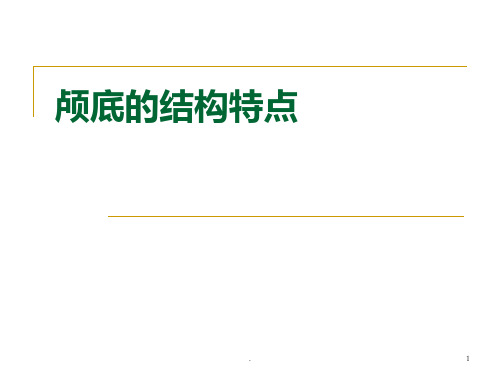
.
16
近颞骨岩部尖端可见三叉神经压迹 trigeminal impression,其外侧稍后方 是岩大神经管裂孔hiatus of canal for greater petrosal n.,岩大神经沟由此向 蝶岩裂延伸。岩小神经管裂孔hiatus of canal for lesser petrosal n. 紧靠岩大神 经管裂孔的前外侧。岩大、小神经之间 的距离为1~3 mm, 有时有交通支联 系。
枕内嵴internal occipital crest自枕内隆
颞骨岩部上缘有发育程度不等的岩上窦 沟groove for superior petrosal sinus 。
弓状隆起arcuate eminence 为一圆钝的 隆起,由前半规管耸起形成。
颞骨鳞部与蝶骨以蝶鳞缝相连结。弓状 隆起前外侧、颞骨岩部前面由鼓室盖 tegmen tympani形成,它是鼓室顶的一 层薄骨板,向前内侧延伸到咽鼓管之上。 隆起的外侧,鼓室盖的后部形成乳突窦 顶。三叉神经压迹之后形成岩上窦沟。 颅中窝以颞骨岩部上缘和鞍背与颅后窝 分隔。
.
4
颅底后部包括蝶骨、颞骨和枕骨。
鼻后孔的内侧界由犁骨构成, 鼻后孔的外侧界由翼突构成
翼突内侧板medial plate及其翼 钩,以及翼突外侧板lateral plate ,二板之间是翼窝。舟状 窝scaphoid fossa位于翼突内侧 板根部,并与破裂孔foramen lacerum 相邻。
颈静脉孔区颈静脉球瘤的影像学诊

颈静脉孔区颈静脉球瘤的影像学诊颈静脉球瘤是发生在颅底颈静脉孔区及其附近的肿瘤,其多发生于颈静脉球外膜的球样小体,故亦被称为颈静脉体瘤。
本病还被称为化学感受器瘤、非嗜铬性副神经节瘤、鼓室体瘤等。
少数具有内分泌功能,特称为嗜铬性颈静脉球瘤或功能性副神经节瘤,这一类约占颈静脉球瘤的1%。
可在10岁以上任何年龄组发病,女性多于男性,常以搏动性耳鸣、听力减退为首发症状[1]。
颈静脉孔区解剖基础[2]骨性结构:颈静脉孔位于外耳道下方和颅后窝岩枕裂的后端,由枕骨的颈静脉切迹和颞骨的同名切迹围成。
其周围结构包括:①前方与颈动脉管以颈动脉嵴相分隔;②后方与乙状窦沟之间以一弯月形骨嵴分界;③内侧与枕骨基板相邻;④外侧与面神经垂直段相邻;⑤上方与鼓室、后半规管、内耳道等结构相邻;⑥下方与舌下神经管相邻。
耳蜗导水管(或称蜗小管)的开口呈喇叭状,位于颈静脉孔的前上方。
前庭小管的外口(或称内淋巴囊裂)位于颈静脉孔的外上方,呈裂隙状。
内耳道、颈静脉孔和舌下神经管自上至下依次排列。
髁管位于颈静脉孔的后内侧。
双侧颈静脉孔常不等大,以右侧颈静脉孔大于左侧更常见。
颈静脉孔分为内口、球部和外口。
从内侧观察,颈静脉孔内存在由颞骨和枕骨形成的伸向孔内的突起,分别称为颞突和枕突。
二者相对不连接,将颈静脉孔分为前后两部分。
神经结构:舌咽神经由延髓橄榄后沟出脑,经舌咽道入颈静脉孔。
在颈静脉孔内口,舌咽神经位于迷走、副神经的前上内方。
进入颈静脉孔后,舌咽神经走行于蜗小管外侧的骨沟内,位于岩下窦的前方或外侧。
在外口处,舌咽神经位于颈静脉球的前内侧,迷走、副神经的前方出颅。
舌咽神经在颈静脉孔下方的岩小窝内形成岩神结节(舌咽神经下神经结),自此节发出鼓室神经(Jacobson神经)。
鼓室神经穿经鼓室小管下口,经鼓室小管入鼓室内侧壁上升,在鼓室岬表面加入鼓室神经丛。
迷走神经自延髓橄榄后沟出脑,与舌咽神经最下根丝相距约2mm,和副神经共同穿迷走道进入颈静脉孔。
解剖学-静脉

静脉
静脉是导血回心的血 管,起于毛细血管, 止于心房。 一、静脉结构和配布 特点 二、体循环静脉
一、静脉结构和配布特点
1.体循环静脉分深、 浅两类.。
2.静脉之间有丰富的 吻合。
3.腔内多有静脉瓣。
4.静脉壁薄,管径粗, 容量大,血流慢,压 力低。
5.几种结构特殊的静 脉:硬脑膜窦或板障 静脉,骨松质。
耳后静脉
颈外静脉
锁骨下静脉
下颌后静 脉后支
头静脉
肘正中 静脉
上肢静脉
深静脉:尺、桡静脉→肱静 脉→腋静脉→锁骨下静脉。 浅静脉:
1、头静脉:手背静脉网的桡 侧→腋静脉或锁骨下静脉。
2、贵要静脉:手背静脉网的 尺侧→肱静脉。
3、 肘正中静脉:于肘窝处连 于头静脉和贵要静脉之间
贵要 静脉
胸部的静脉
胸前部及脐以上 的静脉:
硬脑 膜窦
板障 静脉
上腔静 脉系
下腔 静脉系
三、体循环静脉
体循环的静脉包括 上腔静脉系 下腔静脉系(门静 脉系) 心静脉系
(一)上腔静脉系
上腔静脉系:
收集头颈、上 肢、胸壁及部 分胸腔脏器回 流膈以上上半 身的静脉血, 经上腔静脉回 流入右心房。
上腔 静脉
头臂 静脉
上腔 静脉
1.上腔静脉
为一粗大的静脉干, 在右侧第一胸肋关节 后方由左右头臂静脉 汇合而成,注入右心 房。奇静脉注入上腔 静脉。
深静脉:
浅静脉:
大隐静脉:起于足 背静脉弓内侧→内 踝前方→膝关节内 后方→大腿前面→ 隐静脉裂孔→股静 脉。
小隐静脉:起于足 背静脉弓外侧→外 踝后方→小腿后面 →腘窝→穿深筋膜
→腘静脉。
(1)髂内静脉:收集盆 部的静脉,多起于盆内 的静脉丛(如直肠静脉 丛)。 脏支:直肠下静脉、阴 部内静脉、子宫静脉等。 壁支:臀上静脉、臀下 静脉、闭孔静脉、骶外 侧静脉等。 (2)髂外静脉:续于股 静脉,属支为腹壁下静 脉。 (3)髂总静脉:于骶髂 关节前方由髂内静脉和 髂外静脉汇合而成。
颈部血管解剖

汇报人:可编辑 2024-01-11
目录
• 引言 • 颈部血管概述 • 颈动脉解剖 • 颈静脉解剖 • 颈部血管的毗邻结构 • 颈部血管的应用解剖
01
引言
目的和背景
01
颈部血管解剖是医学领域中重要 的基础学科之一,对于了解人体 血液循环系统、诊断和治疗颈部 血管疾病具有重要意义。
02
CT血管成像
CT血管成像是一种先进的影像学检查方法,可以清晰地显示颈部血管的三维结构。通过CT血管成像 ,医生可以了解血管的走行、分支、管壁等情况,为疾病的诊断和治疗提供更加准确的参考依据。
THANK YOU
感谢各位观看
功能
颈总动脉和颈内动脉主要负责向头部和面部提供血液,而颈外动脉则负责向颈 部和上肢提供血液。这些血管在维持头部和颈部的正常生理功能中起着至关重 要的作用。
03
颈动脉解剖
颈总动脉
颈总动脉是颈部最重要的动脉,分为左右两支,起始于心脏主动脉,上行至头部和 颈部。
它负责向头部和颈部供应血液,提供氧气和营养物质,维持头部的正常生理功能。
颈淋巴结清扫术
颈淋巴结清扫术是治疗头颈部恶性肿 瘤的常用手术方法之一。在手术过程 中,需要熟悉颈部血管的走行和分布 ,以避免损伤血管,减少手术并发症 的发生。
颈部血管与疾病的诊断和治疗
颈动脉狭窄
颈动脉狭窄是一种常见的血管疾病,其诊断和治疗都需要充分了解颈部血管的解剖结构。在诊断方面,医生需要 通过影像学检查了解血管狭窄的程度和位置;在治疗方面,医生需要根据患者的具体情况选择合适的手术或非手 术治疗方法。
颈外动脉
颈外动脉是颈总动脉的另一分 支,主要负责向头部和颈部的 皮肤、肌肉等组织供应血液。
它分为甲状腺上动脉、舌动脉 、面动脉等多个分支,分别供 应相应区域的血液。
中心静脉穿刺置管术(颈内、锁骨下、股静脉)含解剖图谱 ppt课件

1681-4. Epub 2004 May 25.
35
CRBSI——致病菌
36
三腔CVC应当从哪个腔取血
在CRBSI的病例, 40%的CVC仅一个导管腔有细菌的明显定植
随机从一个导管腔留取血培养, 阴性结果的可能性为66% (2/3)
总体而言, 对于CRBSI病例, 随机从一个导管腔留取血培养, 阴性结果 可能性为40%
21
穿利多卡因 2ml b. 试穿,探明位置、方位和深度
22
穿刺置管
a.穿刺路径,保持负压 b.进入静脉,突破感,回血通畅,呈暗红色,
压力不高 c.置导丝,用力适当,无阻力,深浅合适,不
能用力外拔 d.外套管,捻转前进,扩管有度 e.沿导丝置导管
23
封管 回抽血顺畅,先以NS 5-10ml脉冲式
推入,再以肝素盐水1-2ml推入 固定 缝线 ,敷贴
24
注意事项
a. 进针深度: 一般1.5~3cm,肥胖者2~4cm b.注意病人体位和局部解剖标志 c.进针方向与角度不合适,静脉张力过低,
被推扁后贯穿 d.有回血,但导丝推进有困难,顶于对侧壁 e.导丝的刻度、弯头
导管局部感染发 (病/10率00导管留置 )日
15 13.15
10
5
0 股静脉
6.29 颈内静脉
1.81 锁骨下静脉
Lorente L, Villegas J, Martin MM, Jimenez A, Mora ML. Catheter-related infection in critically ill patients. Intensive Care Med. 2004 Aug; 30(8):
笨,没有学问无颜见爹娘 ……” • “太阳当空照,花儿对我笑,小鸟说早早早……”
体循环静脉系统解剖(图文)
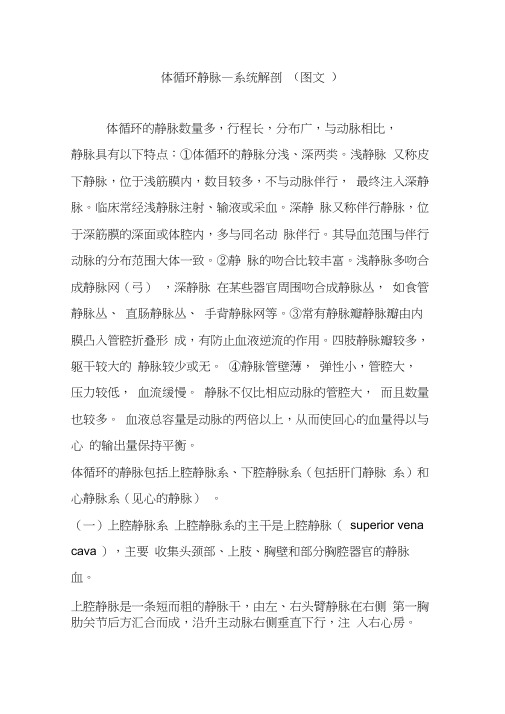
体循环静脉—系统解剖(图文)体循环的静脉数量多,行程长,分布广,与动脉相比,静脉具有以下特点:①体循环的静脉分浅、深两类。
浅静脉又称皮下静脉,位于浅筋膜内,数目较多,不与动脉伴行,最终注入深静脉。
临床常经浅静脉注射、输液或采血。
深静脉又称伴行静脉,位于深筋膜的深面或体腔内,多与同名动脉伴行。
其导血范围与伴行动脉的分布范围大体一致。
②静脉的吻合比较丰富。
浅静脉多吻合成静脉网(弓),深静脉在某些器官周围吻合成静脉丛,如食管静脉丛、直肠静脉丛、手背静脉网等。
③常有静脉瓣静脉瓣由内膜凸入管腔折叠形成,有防止血液逆流的作用。
四肢静脉瓣较多,躯干较大的静脉较少或无。
④静脉管壁薄,弹性小,管腔大,压力较低,血流缓慢。
静脉不仅比相应动脉的管腔大,而且数量也较多。
血液总容量是动脉的两倍以上,从而使回心的血量得以与心的输出量保持平衡。
体循环的静脉包括上腔静脉系、下腔静脉系(包括肝门静脉系)和心静脉系(见心的静脉)。
(一)上腔静脉系上腔静脉系的主干是上腔静脉(superior vena cava ),主要收集头颈部、上肢、胸壁和部分胸腔器官的静脉血。
上腔静脉是一条短而粗的静脉干,由左、右头臂静脉在右侧第一胸肋关节后方汇合而成,沿升主动脉右侧垂直下行,注入右心房。
头臂静脉( brachiocephalic vein )左、右各一,由同侧的颈内静脉和锁骨下静脉在胸锁关节后方汇合而成,汇合处的夹角称静脉角( venous angle ),有淋巴导管注入。
1.头颈部的静脉(1 )颈内静脉( internal jugular vein ):为颈部最大的静脉干。
上端在颈静脉孔处与颅内的乙状窦相延续,伴颈内动脉、颈总动脉下行至胸锁关节后方,与锁骨下静脉汇合成头臂静脉。
颈内静脉与颈总动脉、迷走神经一起被周围结缔组织形成的颈动脉鞘包绕,由于颈动脉鞘与颈内静脉管壁连接紧密,使静脉管腔经常处于开放状态,有利于头颈部静脉血液的回流。
但当颈内静脉损伤破裂时,管腔不易回缩、塌陷,有导致空气进入形成栓塞的危险。
麻醉解剖学之颈部局部解剖的各种定位标志

2011年5月三基三严学习麻醉解剖学之颈部局部解剖的“各种定位标志”主讲人:袁川颈部介于头与胸和上肢之间。
前方正中有呼吸道和消化管的颈段;两侧有纵行排列的大血管和神经等;后方正中有脊柱颈部。
颈根部有胸膜顶、肺尖,以及颈和上肢之间的血管神经束。
颈部肌肉可使头、颈灵活运动,并参与呼吸、吞咽和发音等。
颈部淋巴结较多,主要沿浅静脉和深部血管、神经排列。
一、境界与分区(一)境界上界以下颌骨下缘、下颌角、乳突尖、上项线和枕外隆凸的连线与头部为界;下界以胸骨颈静脉切迹、胸锁关节、锁骨上缘和肩峰至第7 颈椎棘突的连线,分别与胸部及上肢为界。
(二)分区颈部一般分为两大部分:固有颈部和项部。
固有颈部以胸锁乳突肌前、后缘为界,分为颈前区、胸锁乳突肌区和颈外侧区。
颈前区分为舌骨上区和舌骨下区。
二、表面解剖1、舌骨hyoid bone 适对第3、4颈椎间盘平面;舌骨体两侧可扪到舌骨大角,是寻找舌动脉的标志。
2、甲状软骨thyroid cartilage 上缘平第4 颈椎上缘,即颈总动脉分叉处:前正中线上的突起为喉结。
3、环状软骨cricoid cartilage 环状软骨弓两侧平对第6 颈椎横突,是喉与气管、咽与食管的分界标志,又可作计数气管环的标志。
4、颈动脉结节carotid tubercle 即第6颈椎横突前结节。
颈总动脉行经期前方。
平环状软骨弓向后压迫,可阻断颈总动脉血流。
5、胸锁乳突肌sternocleidomastoid 是颈部分区的重要标志。
其起端两头之间称为锁骨上小窝。
6、锁骨上大窝greater supraclavicular fossa 是锁骨中1/3上方的凹陷,窝底可门到锁骨下动脉的搏动、臂丛和第1肋。
7、胸骨上窝位于颈静脉切迹上方的凹陷处,是触诊气管颈段的部位。
(二)体表投影1、颈总动脉及颈外动脉mmon carotid artery and external carotid artery 下颌角与乳突尖连线的中点,右侧至胸锁关节、左侧至锁骨上小窝的连线,即两动脉的投影线;甲状软骨上缘是二者的分界标志。
头颈部解剖

3.颞区层次
皮肤 浅筋膜 颞筋膜浅层 颞筋膜深层 颞肌 颅骨外膜
4.颅顶的血管和神经
前组: 内侧为滑车上动、静脉 和滑车上神经 外侧为眶上动、静脉和 眶上神经 后组: 枕动、静脉,枕大神经 外侧组: 耳前为颞浅动、静脉和 耳颞神经 耳后为耳后动、静脉, 耳大神经,枕小神经
二、颅底内面
一)、颅窝
横突孔
后弓 寰椎
齿突 上关节面
横突孔
椎体 侧块
椎 孔 棘突
枢椎
二、颈椎的连接
关节 关节突关节 寰枕关节 寰枢关节
❖颈部-浅层结构
1.颈阔肌
2.浅静脉
3.浅神经
❖颈部-筋膜与间隙
1.颈筋膜 颈浅筋膜 颈深筋膜 浅层(封套层) 中层(气管前筋膜 或内脏筋膜) 深层(分翼筋膜、 椎前筋膜)
2.筋膜间隙 气管前间隙 咽后间隙 椎前间隙
舌内肌:上、下 纵行,中间横行 和垂直
舌外肌: 舌骨舌肌 颏舌肌 茎突舌肌
血管和神经:
舌动脉:
舌神经-舌的一般躯体感觉和舌前2/3味觉 舌下神经-舌的运动 舌咽神经-舌后1/3味觉
二)、牙 1.牙的形态和结构
2.牙列
牙的种类 • 乳牙:20个 • 恒牙:32个
牙式 • 以“十”记号划分4个
区。 • 左、右,上、下颌。
下颌 缘支 颈支
九、面深层的血管和神经
一)、血管
1.上颌动脉
眼神经
三叉神经节
下颌神经
翼腭神经 和节
上颌神经 颧神经 眶下神经
上牙槽后神经
2.翼丛
二)、神经
下颌神经
前干: 咬肌神经 颞深神经 翼内肌神经 翼外肌神经 颊神经 除颊神经外均为运动支
后干: 耳颞神经 下牙槽神经 下颌舌骨肌神经 舌神经 除下颌舌骨肌神经外均为 感觉支
临床《局部解剖学》题库第01章-头部
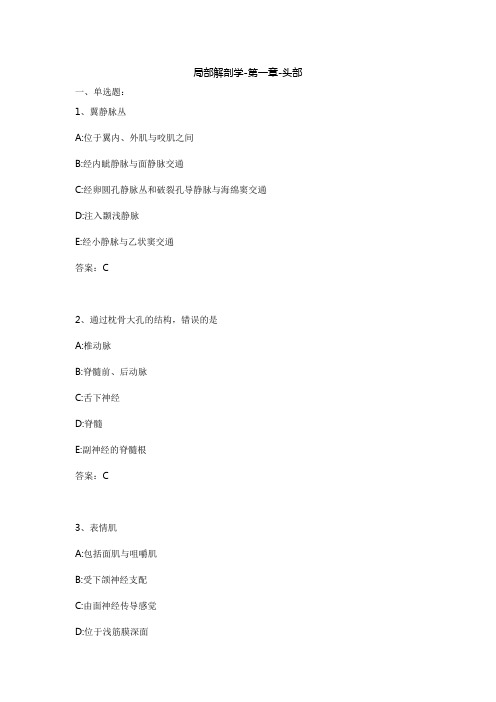
局部解剖学-第一章-头部一、单选题:1、翼静脉丛A:位于翼内、外肌与咬肌之间B:经内眦静脉与面静脉交通C:经卵圆孔静脉丛和破裂孔导静脉与海绵窦交通D:注入颞浅静脉E:经小静脉与乙状窦交通答案:C2、通过枕骨大孔的结构,错误的是A:椎动脉B:脊髓前、后动脉C:舌下神经D:脊髓E:副神经的脊髓根答案:C3、表情肌A:包括面肌与咀嚼肌B:受下颌神经支配C:由面神经传导感觉D:位于浅筋膜深面E:起自颅骨或筋膜,止于皮肤答案:E4、经海绵窦和眶上裂,支配眼外肌的神经是A:第Ⅲ、Ⅳ、Ⅴ对脑神经B:第Ⅲ、Ⅳ、Ⅵ对脑神经C:第Ⅲ、Ⅴ、Ⅵ对脑神经D:第Ⅳ、Ⅴ、Ⅵ对脑神经E:第Ⅲ、Ⅳ、Ⅴ、Ⅵ对脑神经答案:B5、有关腱膜下疏松结缔组织的叙述,错误的是A:又称腱膜下间隙B:头皮借此层与颅骨外膜疏松结合C:颅顶的血管和神经主要位于该层内D:有导静脉穿经E:血肿可蔓延至全颅顶答案:C6、从后向前横穿腮腺的是A:舌咽神经B:舌下神经C:耳颞神经D:舌神经E:面神经答案:E7、翼下颌间隙A:前界为咬肌B:后界为腮腺C:外侧为翼内肌D:内有面神经和舌神经通过E:与咬肌间隙不相通答案:B8、垂体窝A:后方是鞍结节B:两侧为海绵窦C:底与筛窦相邻D:前方为岩上窦E:顶为小脑幕答案:B9、面静脉A:起始于面深静脉B:位于深筋膜深面C:注入甲状腺静脉D:与面动脉紧密伴行E:通过面深静脉与翼丛交通答案:E10、不穿经腮腺的结构A:耳大神经B:面神经C:下颌后静脉D:颈外动脉E:颞浅动脉答案:A11、头皮A:由4层组织构成B:由皮肤和浅筋膜构成C:由皮肤、浅筋膜、帽状腱膜和枕额肌构成D:头皮为头部皮肤E:是颅顶软组织的总称答案:C12、腮腺管A:在颧弓上一横指处向前横行B:在颧弓下一横指处向前横行C:在腮腺前缘穿出位置不恒定D:开口于上颌第1磨牙相对的颊粘膜处E:开口于下颌第2磨牙相对的颊粘膜处答案:B13、颞区软组织的层次依次为A:皮肤和浅筋膜B:皮肤、颞浅筋膜和颞筋膜C:皮肤、颞浅筋膜、帽状腱膜和颞肌D:皮肤、颞浅筋膜、颞筋膜和颞肌E:皮肤、颞浅筋膜、颞筋膜、颞肌和颅骨外膜答案:E14、不参与构成“腮腺床”的结构A:颈内动、静脉B:茎突诸肌C:舌神经D:副神经E:舌咽神经和迷走神经答案:C15、翼点A:在顶、枕、颞、蝶骨连接处B:在顶、枕、颞、筛骨连接处C:在额、顶、颞、蝶骨连接处D:在额、顶、枕、蝶骨连接处E:骨质较厚答案:C16、不是头部与颈部分界线上的结构A:下颌骨下缘B:下颌角C:乳突尖D:外耳门下缘E:枕外隆凸答案:D17、面侧区间隙A:咬肌间隙位于咬肌与下颌支之间B:咬肌间隙前方紧邻第1磨牙C:翼下颌间隙位于翼外肌与下颌支之间D:咬肌间隙内有舌下神经和下牙槽神经通过E:咬肌间隙与翼下颌间隙不相通答案:A18、脑膜中动脉A:为上颌动脉第三段的分支B:经卵圆孔入颅腔C:分布于颞顶区内面的硬脑膜D:经耳颞神经内侧上行E:后支经过翼点内面答案:C19、腮腺鞘A:薄而疏松B:由气管前筋膜延续而成C:浅层薄弱,深层致密D:与腮腺结合疏松E:由颈深筋膜浅层延续而成答案:E20、额顶枕区浅筋膜的特点是A:由疏松结缔组织构成B:血管和神经丰富C:感染时炎症渗出物容易扩散D:创伤后血管断端易回缩闭合E:主要血管是颞浅动脉答案:B二、配伍题:21、将上颌动脉分为3段的标志A:咬肌间隙B:翼下颌间隙C:翼外肌D:翼内肌E:颞下窝答案:C22、舌神经通过A:咬肌间隙B:翼下颌间隙C:翼外肌D:翼内肌E:颞下窝答案:B23、横行穿经腮腺A:面神经分支B:上颌动脉C:颈外动脉D:腮腺管E:面横动脉答案:A24、位于腮腺管上方A:面神经分支B:上颌动脉C:颈外动脉D:腮腺管E:面横动脉答案:E25、海绵窦内,颈内动脉外侧最上方的结构A:展神经B:上颌神经C:动眼神经D:滑车神经E:眼神经答案:C26、海绵窦内,颈内动脉外侧最下方的结构A:展神经B:上颌神经C:动眼神经D:滑车神经E:眼神经答案:B27、为颈外动脉的终支之一,分布于额、颞、顶部软组织A:颞浅动脉B:脑膜中动脉C:面动脉D:舌动脉E:上颌动脉答案:A28、穿经下颌下三角,沿咬肌止点前缘上行A:颞浅动脉B:脑膜中动脉C:面动脉D:舌动脉E:上颌动脉答案:C三、多选题:29、面部“危险三角”的感染可经下列静脉向颅内扩散A:颈外静脉B:眼上静脉C:眼下静脉D:颞浅静脉E:颈内静脉答案:BC30、面部表情肌A:包括眼裂、口裂和鼻孔周围肌B:血液供应主要来源为面横动脉C:受面神经支配D:静脉回流入颈外静脉E:受下颌神经支配答案:AC31、额顶枕区浅筋膜内的血管、神经是A:滑车上血管、神经B:眶上血管、神经C:颞浅血管、耳颞神经D:耳后血管、枕小神经E:枕血管、枕大神经答案:ABE32、由腮腺前缘穿出的结构不包括A:面神经颧支B:耳颞神经C:面横动脉D:舌神经E:腮腺管答案:BD33、纵行穿过腮腺的结构是A:颈外动脉和颈外静脉B:颞浅动脉和耳颞神经C:颈内动脉和迷走神经D:面神经和颈外动脉E:下颌后静脉和颈外动脉答案:BE34、眶上裂处的肿瘤可压迫损伤下列神经A:滑车神经B:动眼神经C:嗅神经D:展神经E:上颌神经答案:ABD35、参与构成“腮腺床”的结构是A:颈内动脉B:迷走神经C:颈内静脉D:副神经E:舌下神经答案:ABCDE36、耳颞神经A:是下颌神经的分支B:两根环绕脑膜中动脉C:常与颞浅动脉伴行D:经下颌颈外侧穿入腮腺鞘E:分布于颞区的皮肤答案:ABCE37、小脑幕切迹上方紧邻的结构是A:视交叉B:滑车神经C:大脑枕叶D:海马旁回E:海马旁回钩答案:DE38、横行穿经腮腺的血管神经是A:上颌动脉B:耳颞神经C:上颌静脉D:面横动、静脉E:面神经颞支答案:ACDE39、通过颈静脉孔的结构有A:舌咽神经B:颈内动脉C:迷走神经D:颈内静脉E:舌下神经答案:ACD40、帽状腱膜A:前连枕额肌额腹B:后连枕额肌枕腹C:参与构成头皮D:横向断裂时,伤口裂开较大E:与骨缝愈合,不易活动答案:ABCD41、颞区软组织的层次有A:皮肤、浅筋膜B:帽状腱膜C:颞筋膜浅、深层D:颞肌E:颅骨外膜答案:ACDE42、头面部的孔或裂中通过的结构A:眶上孔通过滑车神经B:茎乳孔通过面神经C:颏孔内通过颏神经D:下颌孔通过下牙槽神经和下牙槽动脉E:经眶下孔的眶下神经为上颌神经的分支答案:BCDE43、腮腺A:以下颌骨后缘分为浅、深两部B:有腮腺鞘包被C:深部位于下颌后窝内D:下缘平下颌角E:深部突向咽侧壁答案:ABCDE44、属于腮腺咬肌区的结构是A:面神经及其分支B:腮腺和咬肌C:面动脉和面静脉D:下颌后静脉E:颈外动脉答案:ABDE45、通过翼下颌间隙的结构是A:舌神经B:舌动脉C:颊神经D:舌静脉E:下牙槽神经答案:AE四、辨析(判断下列说法正确与否,如果错误,写出正确说法)46、翼下颌间隙内有下牙槽神经和舌下神经通过。
局部解剖学—头颈部(尹)
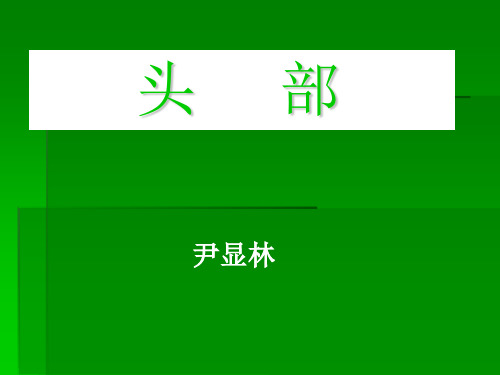
第一段: (下颌段 ) 下牙槽动 脉 脑膜中动脉 第二段: (翼肌段 ) 颞深前 后动脉, 頰动脉 第三段: (翼腭窝段) 上牙槽后动脉 眶下动脉
3. 上颌A
4. 下颌N:
下颌N—颞深前后N、咬肌N、 耳颞N、下牙槽N、舌N 、颊支
咬肌间隙
面 部 的 间 隙
位置—咬肌与下颌支之间的狭隙
内容物—咬肌的血管、神经
腮腺管
起始 行程 毗邻
开口
投影
内容物
浅→深:面N下颌后V颈外A耳颞 N
面N、颞浅AV、 颈外A、上颌AV、 耳颞N、面横AV
走行关系 纵行组:颞浅A V、耳颞N、下 颌后V、颈外A 横行组:上颌A V、面横A V 、 面N
面N (颅外)
行程
分段 特点 意义
下颌后V: 组成 分支 汇入 颈外A: 行程 分支 耳颞N: 来源 行程 意义
气管前筋膜内脏筋膜甲状腺鞘甲状腺悬韧带颊咽筋膜筋膜间隙舌骨上区舌骨下区颏下三角下颌下三角颈动脉三角肌三角颏下三角下颌下腺及下颌面动脉舌下神经舌动脉及舌静脉舌神经下颌下神经节下颌下淋巴二下颌下三角境界内容颈动脉三角境界血管神经颈深淋巴结颈内静脉颈总动脉及分支迷走神经及分支副神经耳大神经下颌后静面神经颈支脉颈内动静脉颈外动脉末三对脑脑神经及颈交感干上缘耳后动脉面神经及舌咽神经下缘枕动脉及舌下神经二腹肌后腹
内 容 物
甲状腺
1、形态与被膜 ① 形态 ② 被摸: 假被膜 (甲状腺鞘) 真被膜 (纤维鞘) 囊鞘间隙 甲状腺悬韧带
2、位置与毗邻 甲状腺肿大 后内侧: 喉和气管, 咽和食管及喉返神 经,呼气、吞咽困 难及声音嘶哑 后外侧 : 颈A鞘、 颈交感干, Horner 综合即面部潮红、无 汗、瞳孔缩小、 眼 裂变窄、上睑下垂及 眼球内陷等
颈静脉孔区静脉窦开口的解剖学研究
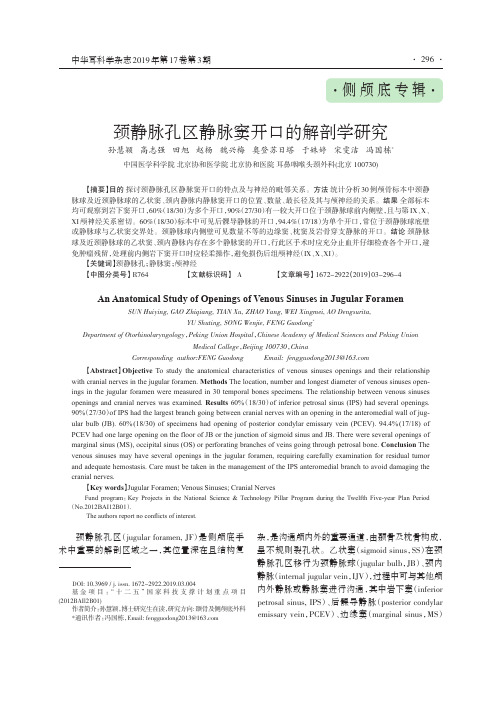
颈静脉孔区静脉窦开口的解剖学研究孙慧颖高志强田旭赵杨魏兴梅奥登苏日塔于姝婷宋雯洁冯国栋*中国医学科学院北京协和医学院北京协和医院耳鼻咽喉头颈外科(北京100730)【摘要】目的探讨颈静脉孔区静脉窦开口的特点及与神经的毗邻关系。
方法统计分析30例颅骨标本中颈静脉球及近颈静脉球的乙状窦、颈内静脉内静脉窦开口的位置、数量、最长径及其与颅神经的关系。
结果全部标本均可观察到岩下窦开口,60%(18/30)为多个开口,90%(27/30)有一较大开口位于颈静脉球前内侧壁,且与第IX、X、XI颅神经关系密切。
60%(18/30)标本中可见后髁导静脉的开口,94.4%(17/18)为单个开口,常位于颈静脉球底壁或静脉球与乙状窦交界处。
颈静脉球内侧壁可见数量不等的边缘窦、枕窦及岩骨穿支静脉的开口。
结论颈静脉球及近颈静脉球的乙状窦、颈内静脉内存在多个静脉窦的开口,行此区手术时应充分止血并仔细检查各个开口,避免肿瘤残留,处理前内侧岩下窦开口时应轻柔操作,避免损伤后组颅神经(IX、X、XI)。
【关键词】颈静脉孔;静脉窦;颅神经【中图分类号】R764【文献标识码】A【文章编号】1672-2922(2019)03-296-4 An Anatomical Study of Openings of Venous Sinuses in Jugular ForamenSUN Huiying,GAO Zhiqiang,TIAN Xu,ZHAO Yang,WEI Xingmei,AO Dengsurita,YU Shuting,SONG Wenjie,FENG Guodong*Department of Otorhinolaryngology,Peking Union Hospital,Chinese Academy of Medical Sciences and Peking UnionMedical College,Beijing100730,ChinaCorresponding author:FENG Guodong Email:fengguodong2013@ 【Abstract】Objective To study the anatomical characteristics of venous sinuses openings and their relationship with cranial nerves in the jugular foramen.Methods The location,number and longest diameter of venous sinuses open-ings in the jugular foramen were measured in30temporal bones specimens.The relationship between venous sinuses openings and cranial nerves was examined.Results60%(18/30)of inferior petrosal sinus(IPS)had several openings. 90%(27/30)of IPS had the largest branch going between cranial nerves with an opening in the anteromedial wall of jug-ular bulb(JB).60%(18/30)of specimens had opening of posterior condylar emissary vein(PCEV).94.4%(17/18)of PCEV had one large opening on the floor of JB or the junction of sigmoid sinus and JB.There were several openings of marginal sinus(MS),occipital sinus(OS)or perforating branches of veins going through petrosal bone.Conclusion The venous sinuses may have several openings in the jugular foramen,requiring carefully examination for residual tumor and adequate hemostasis.Care must be taken in the management of the IPS anteromedial branch to avoid damaging the cranial nerves.【Key words】Jugular Foramen;Venous Sinuses;Cranial NervesFund program:Key Projects in the National Science&Technology Pillar Program during the Twelfth Five-year Plan Period (No.2012BAI12B01).The authors report no conflicts of interest.·侧颅底专辑·颈静脉孔区(jugular foramen,JF)是侧颅底手术中重要的解剖区域之一,其位置深在且结构复杂,是沟通颅内外的重要通道,由颞骨及枕骨构成,呈不规则裂孔状。
手术讲解模板:颈静脉孔病损切除术

手术资料:颈静脉孔病损切除术
颈静脉孔病损切除术
科室:神经外科 部位:颈部 麻醉:全身麻醉
手术资料:颈静脉孔病损切除术
概述:
颈静脉球体瘤(glomus jugulare tumors) 也称为非嗜铬性副神经节瘤 (nonchromaffin paraganglioma)或化 学受体瘤(receptoma)和鼓室体瘤 (tympanic body tumor)等。颈静脉体 是和颈动脉体或主动脉体相同的微小组织 结构
手术资料:颈静脉孔病损切除术
概述: 2.下鼓室切开术(hypotympanotomy), 方法同上,同时去除鼓沟下骨质,暴露下 鼓室(A期)。
手术资料:颈静脉孔病损切除术
概述: 3.乳突根治性凿除术 与“乳突根治术” 基本相同,注意保护面神经(B期)。
手术资料:颈静脉孔病损切除术
概述:
4.颞骨部分或全部切除术 与“次全颞骨 切除术”和“全颞骨切除术”节基本类似 (C和D期)。由于肿瘤大,已侵入颈静脉 孔、岩锥或颅内,采取暴露颈静脉孔和岩 锥的颞下窝进路手术。
术前准备: 2.行X线平片、断层片、CT和MRI检查,确 定肿瘤局限于鼓室乳突区。
手术资料:颈静脉孔病损切除术
术前准备: 3.术前1d剃发与中耳乳突手术相同。
手术资料:颈静脉孔病损切除术
术前准备: 4.作血尿常规、出凝血时间、肝肾功能检 查、心肺功能检查。
手术资料:颈静脉孔病损切除术
术前准备: 5.普鲁卡因及青霉素皮肤过敏试验。
手术资料:颈静脉孔病损切除术
手术步骤:
4.彻底止血,有条件者行鼓室成形术;无条件者即形成乳突根治腔,腔内 植皮,压以碘仿纱条缝合切口,包扎。
手术资料:颈静脉孔病损切除术
颈部解剖(局解)
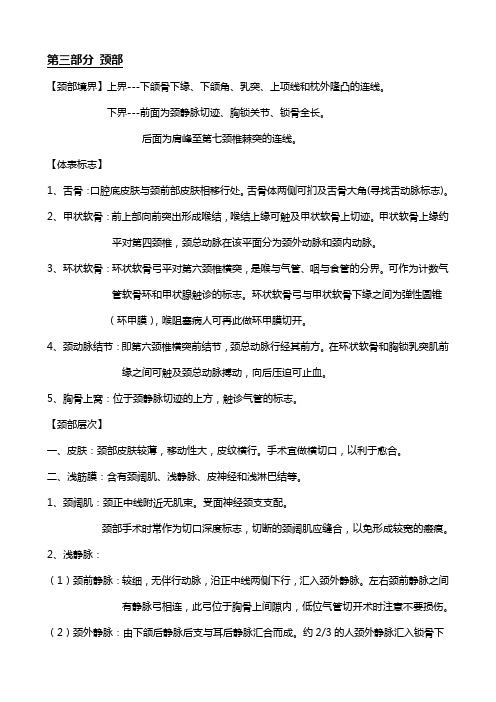
第三部分颈部【颈部境界】上界---下颌骨下缘、下颌角、乳突、上项线和枕外隆凸的连线。
下界---前面为颈静脉切迹、胸锁关节、锁骨全长。
后面为肩峰至第七颈椎棘突的连线。
【体表标志】1、舌骨:口腔底皮肤与颈前部皮肤相移行处。
舌骨体两侧可扪及舌骨大角(寻找舌动脉标志)。
2、甲状软骨:前上部向前突出形成喉结,喉结上缘可触及甲状软骨上切迹。
甲状软骨上缘约平对第四颈椎,颈总动脉在该平面分为颈外动脉和颈内动脉。
3、环状软骨:环状软骨弓平对第六颈椎横突,是喉与气管、咽与食管的分界。
可作为计数气管软骨环和甲状腺触诊的标志。
环状软骨弓与甲状软骨下缘之间为弹性圆锥(环甲膜),喉阻塞病人可再此做环甲膜切开。
4、颈动脉结节:即第六颈椎横突前结节,颈总动脉行经其前方。
在环状软骨和胸锁乳突肌前缘之间可触及颈总动脉搏动,向后压迫可止血。
5、胸骨上窝:位于颈静脉切迹的上方,触诊气管的标志。
【颈部层次】一、皮肤:颈部皮肤较薄,移动性大,皮纹横行。
手术宜做横切口,以利于愈合。
二、浅筋膜:含有颈阔肌、浅静脉、皮神经和浅淋巴结等。
1、颈阔肌:颈正中线附近无肌束。
受面神经颈支支配。
颈部手术时常作为切口深度标志,切断的颈阔肌应缝合,以免形成较宽的瘢痕。
2、浅静脉:(1)颈前静脉:较细,无伴行动脉,沿正中线两侧下行,汇入颈外静脉。
左右颈前静脉之间有静脉弓相连,此弓位于胸骨上间隙内,低位气管切开术时注意不要损伤。
(2)颈外静脉:由下颌后静脉后支与耳后静脉汇合而成。
约2/3的人颈外静脉汇入锁骨下静脉,1/3的人汇入颈内静脉。
颈外静脉虽有一对静脉瓣,但不能有效阻止血液逆流,故上腔静脉回流受阻时(如右心衰),颈外静脉可明显扩张。
颈外静脉管壁与颈深筋膜紧密结合,颈外静脉破裂时,管腔不易闭合,可致空气栓塞。
3、皮神经:(1)颈丛皮支:在胸锁乳突肌后缘中点处浅出,共四条--枕小、耳大、颈横、锁骨上神经。
颈横神经--横越胸锁乳突肌表面,分为上支和下支分布于颈前区皮肤。
头部(颅脑断层解剖基础)-断层
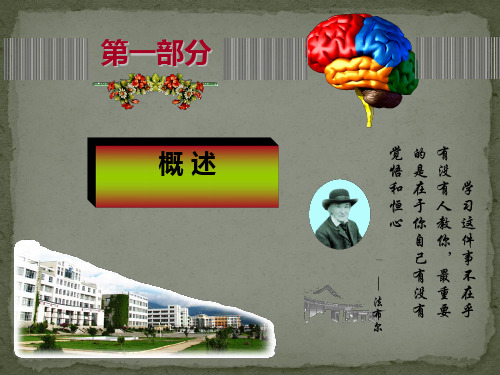
下颌角:下颌支后缘与下颌骨下缘 相交处。
颏孔:位于下颌体的外侧面,正对 下颌第一、二前磨牙间的下方,下颌 体上、下缘连线中点略上,距正中线 约2.5CM,内有颏神经和血管通过。
眉弓:眶上缘上方的弓状隆起,男性明显,正对大脑额叶的 下缘,其内侧份的深面有额窦,位于眉毛的底下。
颧弓:位于外耳门前方的水平线上,全长约三横指(56cm),于皮下可触及。颧弓上缘相当于大脑颞叶前端下缘。
翼点:位于颧弓中点上方约2横指处,内有脑膜中动脉前支 通过。
乳突:位Байду номын сангаас耳后骨隆起处,其根部前内方有面神经从茎乳孔 穿出,其后颅底内面有乙状窦。
枕外隆凸:为头后正中最凸的隆起, 其内面是窦汇。
乳突囟
前囟 后囟
第三部分
脑及其被膜
一、脑的应用解剖(熟悉)
1、端脑 Telencephalon
概述: 左右半球胼胝连, 两裂三面又三端; 三沟五叶藏脑室, 基底内囊半卵圆。 中枢皮质运动感, 视听说写四语言。
端脑外形:
(1)端脑外侧面的脑沟、脑回和功能定位
(2)端脑内侧面的脑沟、脑回和边缘系统
1.新生儿由于脑和感觉器官比咀嚼器官发育早而快, 故脑颅远大于面颅(8:1)。 2.顶结节、额结节和枕鳞都是骨化的中心部位,故 发育较明显,使颅顶呈五角形。 3.新生儿颅骨尚未发育完全,骨与骨之间的间隙较 大,由膜弥补,形成前囟(生后1-2岁闭合)、后 囟、蝶囟、乳突囟(生后半年闭合)。
颅囟
蝶囟
C. 下角:最大,呈弓形裂隙状,冠状层面上呈半月形。经背 侧丘脑后下方弯向前下方,伸入颞叶。
顶壁为胼胝体、尾状核尾、终纹和杏仁体; 外侧壁为胼胝体; 底壁为海马、海马伞和侧副隆起。
颈静脉插管PPT课件

SUCCESS
THANK YOU
2019/9/30
适应证
PAWP>LVEDP
PAWP<LVEDP
1.正压通气
脉瓣返流
2.PEEP 左心室顺应性降低
3.胸内压↑ 脉分支减少
4.PAC不在肺III区 术、肺栓塞 )
5.慢性阻塞性肺疾患 6.心动过速 7.肺血管阻力↑ 8.二尖瓣阻塞(狭窄) 9.肺静脉受压(肿瘤)
1.主动
2. 3.肺动 (全肺切除
PCWP>LVEDP
适应证
治疗 a. 外周静脉穿刺困难 b. 长期输液治疗 c. 大量、快速扩容通道 d. 胃肠外营养治疗 e. 药物治疗(化疗、高渗、刺激性) f. 血液透析、血浆置换术
监测 a. 危重病人抢救和大手术期行CVP监测 b Swan-Ganz导管监测 c 心导管检查明确诊断
急救 a. 放置起搏器电极 b 急救用药
* 表现: a.突发紫绀,颈静脉怒张,恶心,胸骨后疼痛, 呼吸困难 b.低血压、脉压变窄、奇脉、心音低远
* 急救: a.立即中止经深静脉导管注输 b.将CVC输注器的高度降之低于病人心脏水平 c.若经导管吸出的液体很少,病情又未得到改 善,考虑行心包穿刺减压
* 预防: a.选用质软,硬度适当的导管 b.置管不宜过深(12~14cm),管端位于上腔静 脉或右房入口处为宜 c.防止导管移动,固定确切 d.注意观察导管回血情况,当测压水平面不 随 呼吸波动或显著异常,或发生房早、室早 等
- 1、下载文档前请自行甄别文档内容的完整性,平台不提供额外的编辑、内容补充、找答案等附加服务。
- 2、"仅部分预览"的文档,不可在线预览部分如存在完整性等问题,可反馈申请退款(可完整预览的文档不适用该条件!)。
- 3、如文档侵犯您的权益,请联系客服反馈,我们会尽快为您处理(人工客服工作时间:9:00-18:30)。
J UGULAR F ORAMENThe jugular foramen is located between the temporal and the occip-ital bones. It can be regarded as a hiatus between the temporal and the occipital bones (1). The right foramen is usually larger than the left. The foramen is configured around the sigmoid and inferior petrosal sinuses. The jugular foramen is divided into three compartments: two venous compartments and a neural or intrajugular compartment. The venous compartments consist of a larger posterolateral venous channel, the sigmoid part, which receives the flow of the sigmoid sinus, and a smaller anteromedial venous channel, the petrosal part, which receives the drainage of the inferior petrosal sinus. The petrosal part forms a characteristic venous confluens by also receiving tributaries from the hypoglossal canal, petroclival fissure, and vertebral venous plexus. The petrosal part empties into the sigmoid part through an opening between the glossopharyngeal and the vagus nerves in the medial wall of the jugular bulb. The intrajugular or neural part, through which the glossopharyngeal, vagus, and accessory nerves course, is located between the sigmoid and petrosal parts. The junction of the sigmoid and petrosal parts of the foramen, when viewed from above, is the site of bony prominences on the opposing surfaces of the temporal and occipital bones, called the intrajugular processes, which are joined by a fibrous, or, less commonly, an osseous bridge, the intrajugular sep-tum, separating the sigmoid and petrosal part of the foramen. The glossopharyngeal, vagus, and accessory nerves penetrate the dura on the medial margin of the intrajugular process of the temporal bone to reach the medial wall of the jugular bulb and internal jugular vein. The jugular foramen is difficult to access surgically. The difficulties in exposing this foramen are created by its deep location and the sur-rounding structures, such as the carotid artery anteriorly, the facial nerve laterally, the hypoglossal nerve medially, and the vertebral artery inferiorly, all of which block access to the foramen and require careful management.The structures that traverse the jugular foramen are the sigmoid sinus and jugular bulb, the inferior petrosal sinus, meningeal branches of the ascending pharyngeal and occipital arteries, the glossopharyn-geal, vagus, and accessory nerves with their ganglia, the tympanic branch of the glossopharyngeal nerve (Jacobson’s nerve), the auricular branch of the vagus nerve (Arnold’s nerve), and the cochlear aqueduct. Tumors involving the jugular foramen can extend as follows: 1) along the eustachian tube into the nasopharynx and through the foramina at the base of the cranium, 2) along the carotid artery to the middle fossa, 3) through the intracranial orifice of the jugular foramen or along the hypoglossal canal to the posterior fossa, 4) through the tegmen tym-pani to the floor of the middle fossa, 5) through the round window and the internal acoustic meatus to the cerebellopontine angle, and 6) through the extracranial orifice of the jugular foramen to the upper cer-vical region.Surgical ApproachesThe most common operative approaches used to access various aspects of the foramen and adjacent areas are the postauricular transtemporal, retrosigmoid, and far lateral approaches. Postauricular Transtemporal ApproachThe postauricular transtemporal approach, the most common approach selected for a lesion in the jugular foramen, accesses the region from laterally, through the mastoid, and from below, through the neck. A C-shaped postauricular skin incision provides the exposure for a mastoidectomy and the neck dissection. The external auditory canal is either preserved or transected, depending on the anterior extent of the pathological abnormality. The neck dissection is com-pleted initially to gain control of the major vessels and the branches supplying the tumor. The internal carotid artery, branches of the exter-nal carotid artery, internal jugular vein, and lower cranial nerves are exposed in the carotid sheath. A mastoidectomy with extensive drilling of the infralabyrinthine region accesses the jugular bulb. A limited mas-toidectomy confined to the area behind the stylomastoid foramen and mastoid segment of the facial nerve, combined with removal of the adjacent part of the jugular process of the temporal bone, will provide access to the posterior and posterolateral aspect of the jugular foramen. Three obstacles to exposure of the full lateral half of the jugular fora-men, the facial nerve, styloid process, and rectus capitis lateralis mus-cle are dealt with by transposing the facial nerve, removing the styloid process, and dividing the rectus capitis lateralis muscle. Anterior exten-sions of the pathological abnormality are reached by sacrificing the external and the middle ear structures. Sensorineural hearing can be preserved by maintaining the footplate of the stapes in the oval win-dow to avoid opening the labyrinth. Intracranial extensions of the lesion are reached by the retrosigmoid or presigmoid approaches after adding a suboccipital craniectomy. Some lesions can be removed by a transtemporal infralabyrinthine approach directed through the tem-poral bone below the labyrinth without a neck dissection, if the extracranial extension of the lesion is not prominent. The exposure can be extended by opening the otic capsule (translabyrinthine approach). Retrosigmoid ApproachA lesion located predominantly intradurally above the jugular fora-men can be resected by the retrosigmoid approach. A lateral suboccip-ital craniectomy exposes the dura behind the sigmoid sinus. The dura is opened, and the cerebellum is gently elevated away from the poste-rior surface of the temporal bone to expose the cisterns in the cerebel-lopontine angle and the intracranial aspect of the cranial nerves enter-ing the jugular foramen, hypoglossal canal, and internal acoustic meatus. Lesions can be followed into only the upper part of the fora-men by this approach.Far Lateral ApproachAn extended modification of the retrosigmoid approach, the far lat-eral approach, may be selected if the tumor extends down to the fora-men magnum in front of or lateral to the lower brainstem. In this approach, the jugular foramen is opened from behind by completing a paracondylar modification of the far lateral approach. In this modifica-tion, the rectus capitis lateralis is detached from the occipital bone at the posterior margin of the foramen and the posterior margin is removed. The dura is opened and the cerebellum elevated to expose the intracranial extension of the pathological abnormality at the lower clivus and at the foramen magnum. In another variant of the approach, depending on the location and extent of the pathological abnormality, the jugular tubercle is removed extradurally to minimize the retraction of the brainstem needed to reach the area anterior to the medulla and pontomedullary junction. Most jugular foramen tumors cannot be reached by this route because they extend forward beyond the limits of this approach to the posterior part of the foramen.REFERENCES1.Rhoton AL Jr: Jugular foramen. Neurosurgery47[Suppl 3]:S267–S285, 2000.R HOTONFIGURE 12-1.Jugular foramen. Posterior view of the cranial base with the cranial nerves and arteries pre-served. The j ugular foramen is posi-tioned below the internal acoustic meatus and superolateral to the hypoglossal nerves entering the hypoglossal canal. The glossopharyn-geal, vagus, and accessory nerves enter the dural roof of the j ugular foramen. The superior cerebellar arter-ies arise at the midbrain level and pass below the oculomotor and trochlear nerves and above the trigeminal nerve. The anterior inferior cerebellar arteries arise at the pontine level and course by the abducens, facial, and vestibulocochlear nerves. The poste-rior inferior cerebellar arteries arise from the vertebral artery at the medullary level and course near the glossopharyngeal, vagus, accessory, and hypoglossal nerves.J UGULAR F ORAMENFIGURE 12-2.The dural roof of the left jugular foramen has been exposed below the facial andvestibulocochlear nerves. There is a dural septum between the glossopharyngeal and vagusnerves at the roof of the jugular foramen. The glossopharyngeal nerve is often adherent to therootlets of the vagus nerve in the cistern, however, at the roof of the jugular foramen, there isconsistently a dural septum separating the glossopharyngeal from the vagus nerve. The glos-sopharyngeal nerve enters a shallow meatus, the glossopharyngeal meatus, in the dural roof ofthe foramen. The glossopharyngeal dural fold passes above the glossopharyngeal nerve at theentrance to the glossopharyngeal meatus. The vagus nerve enters the vagal meatus, which isbroader than, but not as deep, as the glossopharyngeal meatus, at the roof of the jugular fora-men. There is also a dural fold around the upper and lateral margin of the vagal meatus. Theaccessory nerve ascends to enter the lower part of the vagal meatus.R HOTONFIGURE 12-3.The left sigmoid and infe-rior petrosal sinuses have been unroofed. The glossopharyngeal, vagus, and acces-sory nerves are exposed at the roof of the jugular foramen. The jugular foramen has three parts: sigmoid, petrosal, and intra-jugular. The sigmoid sinus descends and turns forward to pass through the sigmoid part of the jugular foramen. The inferior petrosal sinus descends and passes through the petrosal part of the j ugular foramen. The glossopharyngeal, vagus, and accessory nerves exit the cranium through the intrajugular part of the fora-men, which is located between the sigmoid and petrosal parts. Two bundles of hypoglossal rootlets enter a bifid hypoglos-sal canal above the occipital condyle and join after exiting the hypoglossal canal.FIGURE 12-4.The jugular bulb has been removed to expose the j ugular fossa on the lower surface of the tem-poral bone. The glossopharyngeal nerve enters the j ugular foramen above and medial to the vagus nerve. The tympanic branch (Jacobson’s nerve) of the glossopharyngeal nerve arises in the medial part of the jugular fossa, ascends to cross the promontory in the tympanic cavity, and gives rise to the lesser petrosal nerve. The auric-ular branch (Arnold’s nerve) of the vagus nerve arises in the intrajugular part of the foramen and passes later-ally across the anterior margin of the j ugular fossa. The bone above the hypoglossal canal has been drilled to expose a bifid hypoglossal canal. The two bundles of hypoglossal rootlets j oin at the extracranial end of the hypoglossal canal and descend in the carotid sheath with the glossopharyn-geal, vagus, and accessory nerves.J UGULAR F ORAMENR HOTONFIGURES 12-5 AND 12-6.Inferior view of the temporal bone and jugular foramen. Figure 12-5,the internal jugular vein is exposed below the jugular foramen and descends on the medial side of the facial nerve and styloid process. The glossopharyngeal, vagus, accessory, and hypoglossal nerves descend in the carotid sheath with the internal carotid artery and internal jugular vein. The occipital condyle has been drilled to expose the passage of the hypoglossal nerve behind the vertebral artery and through the hypoglossal canal. The mandibular head, which sits in the mandibular fossa, is exposed anterolateral to the jugular foramen. The middle meningeal artery and branches of the third trigemi-nal division are exposed below the greater sphenoid wing in the infratemporal fossa. Bone has been removed to expose the eustachian tube and the petrous segment of the internal carotid artery. The Vidian nerve, which arises from the union of the greater and deep petrosal nerves, continues forward in the Vidian canal. The rectus capitis lateralis muscle attaches to the occipital bone behind the jugular foramen. The auriculotemporal branch of the third trigeminal division conveys autonomic fibers from the lesser petrosal nerve to the otic ganglion, which provides auto-nomic innervation to the parotid gland.FIGURE 12-6.The rectus capitis lateralis muscle has been resectedand the part of the occipital bone forming the posterior margin of thejugular foramen has been removed to expose the lower part of thesigmoid sinus as it hooks forward to form the j ugular bulb. Thevenous plexus in the hypoglossal canal has been removed. The infe-rior petroclival vein, which courses along the extracranial surface ofthe petroclival fissure, has been removed to expose the petrous apexarticulating with the lateral edge of the clivus along the petroclivalfissure.J UGULAR F ORAMENR HOTONFIGURE teral view of the left tympanic cavity and mastoid area. The tympanic part of the temporal bone, which forms the lower and anterior margin of the external meatus, has been removed, but the tympanic sulcus and osseous ring to which the tympanic membrane attaches has been preserved. The carotid ridge separates the carotid canal and jugular foramen. Meningeal branches of the ascending pharyngeal and occipital arteries enter the jugular fora-men. The glossopharyngeal, vagus, and accessory nerves pass through the jugular foramen on the medial side of the jugular bulb. The malleus, incus, and stapes are exposed in the tympanic cavity. The stylomastoid branch of the occipital artery joins the facial nerve at the stylomas-toid foramen. The surface of the temporal and occipital bones surrounding the jugular foramen and carotid canal has an irregular surface that serves as the site of attachment of the upper end of the carotid sheath. The mastoid segment of the facial nerve and the stylomastoid foramen are situated lateral to the jugular bulb. The chorda tympani arises from the mastoid segment of the facial nerve and courses along the deep surface of the tympanic membrane and crosses the upper part of the handle of the malleus.FIGURE teral view of the left tympanic cavity, mastoid area, and adjacent part of the infratempo-ral fossa. The tympanic segment of the facial nerve passes below the lat-eral semicircular canal and turns downward to form the mastoid seg-ment, which exits the stylomastoid foramen. The stylomastoid foramen and the mastoid segment are posi-tioned lateral to the j ugular bulb. The semicircular canals are located above the j ugular bulb. The third trigeminal division exits the fora-men ovale to enter the infratemporal fossa. The chorda tympani arises from the mastoid segment of the facial nerve, courses along the deep surface of the tympanic membrane, crosses the upper part of the handle of the malleus, exits the cranium by passing through the petrotympanic fissure, and joins the lingual branch of the mandibular nerve in the infratemporal fossa.J UGULAR F ORAMENR HOTONFIGURE 12-9.The floor of the mid-dle fossa and the tympanic ring have been removed to expose the j ugular bulb and petrous carotid. The jugular bulb is positioned below the semicir-cular canals. The junction of the ver-tical and horizontal segments of the petrous carotid is positioned below the cochlea. The malleus and medial wall of the tympanic cavity have been preserved. The eustachian tube extends downward and medially across the anterior surface of the petrous carotid. The third trigeminal division has been elevated out of the foramen ovale.FIGURE 12-10.A short segment of theEustachian tube has been removed to exposemore of the horizontal segment of thepetrous carotid. The greater petrosal nervecourses along the floor of the middle fossaon the upper surface of the petrous carotid.The deep petrosal nerves arise from the sym-pathetic nerves accompanying the internalcarotid artery. The deep and greater petrosalnerves join to form the vidian nerve, whichpasses forward through the vidian canal toj oin the maxillary nerve and pterygopala-tine ganglion in the pterygopalatine fossa.The pharyngobasilar fascia has been openedto expose the upper part of the longus capi-tis muscle.FIGURE 12-11.The internal carotid artery has been displaced forward out of the carotid canal to expose the carotid nerves, which arise in the cervical sympathetic ganglia and ascend with the artery. The glossopharyngeal, vagus, accessory, and hypoglossal nerves exit the cra-nium on the medial side of the internal carotid artery and jugular vein. The hypoglossal nerve passes forward along the lateral surface of the internal carotid artery, and the accessory nerve descends posteriorly across the lateral surface of the internal jugular vein. The vagus nerve descends in the carotid sheath. The glossopharyngeal nerve descends along the medial side of the internal carotid artery.FIGURE 12-12.The j ugular bulb, positioned below thevestibule and semicircular canals, has been removed. Thevertical segment of the petrous carotid has been removedwhile preserving the horizontal segment. The cochlea,which has been opened, is located above the lateral genu ofthe petrous carotid artery. The tympanic segment of thefacial nerve passes between the lateral semicircular canaland oval window. The mastoid segment of the nerve descends lateral to the jugular fossa.FIGURE 12-13.Posterior view of the nerves in the jugular foramen with the venous struc-tures removed. The posterior wall of the j ugular foramen and hypoglossal canal have been opened. The glossopharyngeal nerve enters the jugular foramen caudal to the cochlear aqueduct.The vagus nerve enters the jugular foramen behind the glossopharyngeal nerve. The auricu-lar branch of the vagus nerve (Arnold’s nerve) arises at the level of the superior ganglion and passes across the anterior wall of the jugular bulb. The accessory nerve is formed by multiple rootlets that arise from the medulla and cervical spinal cord and collect together to form a bun-dle that blends into the lower margin of the vagus nerve at the level of the jugular foramen. The vagal and accessory rootlets cross the surface of the jugular tubercle. The glossopharyngeal nerve expands at the site of the superior and inferior ganglia. The superior ganglion of the vagus nerve is located at the level of or just below the dural roof of the foramen, and the infe-rior ganglion is located below the foramen at the level of the atlanto-occipital joint.FIGURE 12-14–12-21.Postauri-men. Figure 12-14, the C-shapedretroauricular incision (lower left)provides access for the mastoidec-tomy, neck dissection, and reflectingthe parotid gland forward. The scalpflap and superficial muscles havebeen reflected forward to expose theposterior part of the parotid gland,the posterior belly of the digastricmuscle, the internal j ugular veinand longissimus capitis, and the superior and inferior oblique muscles.FIGURE 12-15.A mastoidectomy has been completed to expose the facial nerve, sigmoid sinus, j ugular bulb, and the osseous capsule of the semicircular canals. The facial nerve and styloid process block access to the extracranial orifice of the j ugular foramen. The facial nerve crosses the lateral surface of the styloid process.The stylomastoid artery arises from the postauricular artery and joins the facial nerve at the stylomastoid fora-men. The superior and inferior oblique and levator scapulae muscles attach to the transverse process of C1.FIGURE 12-16.The tympanic membrane and the posterior part of the tympanic sulcus and ring have been removed while preserving the ossicles. A cuff of tissues around the facial nerve has been preserved at the stylomastoid foramen to avoid dissec-tion directly on the surface of the nerve and also to preserve the vascu-lar supply to the nerve from the sty-lomastoid artery. It will be necessary to resect the tympanic ring if the pathology must be followed into the Eustachian tube or along the petrous carotid artery. Some hearing will be preserved if the stapes remains in theoval window.FIGURE 12-17.The external audi-tory canal has been transected and the middle ear structures have been removed, except the stapes, which has been left in the oval window. The lat-eral edge of the jugular foramen has been exposed by completing the mas-toidectomy, transposing the facial nerve anteriorly, and fracturing the styloid process across its base and reflecting it caudally. The rectus capi-tis lateralis muscle has been detached from the jugular process of the occip-ital bone. The petrous carotid is sur-rounded in the carotid canal by a venous plexus.FIGURE 12-18.The dura behind the sigmoid sinus has been opened to expose the facial and vestibulo-cochlear nerves entering the internal acoustic meatus and the glossopha-ryngeal and vagus nerves entering the j ugular foramen. The vertebral artery is exposed medial to the nerves.FIGURE 12-19.A segment of the sigmoid sinus, j ugular bulb, and internal j ugular vein have been removed. The lateral wall of the jugular bulb has been removed while preserving the medial wall and the opening of the inferior petrosal sinus into the lower part of the bulb. The glossopharyngeal, vagus, accessory,and hypoglossal nerves are exposed below the j ugular bulb. The likeli-hood of preserving these nerves in exposing a jugular foramen lesion is greatly enhanced if the medial venous wall can be preserved. The main inflow from the inferior pet-rosal sinus is directed between the glossopharyngeal and vagus nerves.FIGURE 12-20.The medial venous wall ofthe j ugular bulb has been removed. Theintrajugular ridge extends forward from theintraj ugular process of the temporal bonealong the medial side of the jugular bulb. Theglossopharyngeal, vagus, and accessorynerves enter the dura on the medial side ofthe intrajugular process, but only the glos-sopharyngeal nerve courses through the fora-men entirely on the medial side of the intra-jugular ridge.N EUROSURGERY VOLUME 61|NUMBER 4|OCTOBER 2007SUPPLEMENT 4|S4-249J UGULAR F ORAMENS4-250|VOLUME 61|NUMBER 4|OCTOBER 2007 SUPPLEMENT RHOTONFIGURE 12-21.The intrajugular process and ridge have been removed to expose the passage of the glossopharyngeal, vagus, and accessory nerves through the jugular foramen. The tip of a right-angle probe identifies the lower end of the cochlear aqueduct just above where the glossopha-ryngeal nerve penetrates the dura. A., artery; Ac., acoustic; A.I.C.A ., anterior inferior cerebel-lar artery; Asc., ascending; Atl., atlanto; Aur., auricular; Auriculotemp., auriculotemporal;Bas., basilar; Br., branch; Cap ., capitis; Car., carotid; Chor., chorda, choroid; Cliv ., clival; CN ,cranial nerve; Coch., cochlear; Cond., condyle; Eust., eustachian; Ext., external; Fiss., fissure;Flocc., flocculus; For., foramen; Gang., ganglion; Gl., gland; Glossopharyng., glossopharyn-geal; Gr., greater; Hypogl., hypoglossal; Inf., inferior; Int., internal; Intrajug., intrajugular;Jug., j ugular; Lat., lateral, lateralis; Long ., longus; Longiss., longissimus; M., muscle;Mandib., mandibular; Mast., mastoid; Max ., maxillary; Med., medial; Men ., meningeal;Mid., middle; N., nerve; Obl., oblique; Occip., occipital; Pet., petro, petrosal, petrous; Pharyng.,pharyngeal; Plex., plexus; P .I.C.A ., posterior inferior cerebellar artery; Post., posterior; Proc.,process; Pterygopal., pterygopalatine; Rec., rectus; S.C.A ., superior cerebellar artery; Seg., seg-ment; Semicirc., semicircular; Sig., sigmoid; Stylomast., stylomastoid; Sup., superior; Tens.,tensor; Trans., transverse; Tymp., tympanic, tympani; V ., vein; V ert., vertebral.。
